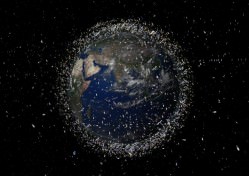[/caption]
NASA tracked a piece of orbital debris that came fairly close to space shuttle Atlantis and the Hubble Space Telescope Wednesday evening, but decided no evasive maneuver was required. A 4 inch (10 cm) chunk of a Chinese satellite that was destroyed in a 2007 anti-satellite test came within 1.7 miles (2.8 km) ahead and 150 meters below Atlantis at its closest approach. These potential orbital impacts seem to be occurring routinely for the ISS, and previous shuttle missions have been forced to maneuver out of the way to avoid collisions. The satellite collision in February destroyed a functional satellite, and seemingly, it will be only a matter of time until a serious impact could endanger human lives in orbit. Last week, experts gathered at the International Interdisciplinary Congress on Space Debris, at McGill University in Montreal, Canada and concluded that action must be taken now to reduce the threat to both human spaceflight and satellites from destructive space debris.
“Space debris is primarily a global issue. Global problems need globally solutions, which must be effectively implemented internationally as well as nationally,” said McGill University’s Ram Jakhu, Chair of the Congress.

Over the past decade and a half, the world’s major space agencies have been developing a set of orbital debris mitigation guidelines aimed at stemming the creation of new space debris and lessening the impact of existing debris on satellites and human spaceflight. Most agencies are in the process of implementing or have already implemented these voluntary measures which include on-board passive measures to eliminate latent sources of energy related to batteries, fuel tanks, propulsion systems and pyrotechnics.
But the growing number of developing countries that are launching using satellites, and they need to be encouraged to use these measures as well.
Last week’s Congress suggested that the mitigation guidelines should become mandatory instead of just voluntary, and another possibility mentioned was the establishment of an international regime for dealing with orbital debris similar to the Missile Technology Control Regime, or perhaps the Limited Test Ban Treaty of 1963. There are a variety of other means within international law as well, including codes, declarations and treaties.
Up until now, the debris mitigation process has been focused mainly on the technical aspects, with an enormous amount of research producing excellent recommendations, noted Brian Weeden, Technical Consultant for the Secure World Foundation.
“However, the community is now starting to focus on the legal aspect, which is critical for broadening and strengthening the adoption of debris mitigation guidelines and space safety in general,” Weeden said.
Weeden explained that the recent Congress explored lessons from terrestrial environmental pollution law as well as maritime law that could be applicable to outer space. Furthermore, international law isn’t necessarily the only method for implementing the guidelines. “We are also looking at a variety of other mechanisms, to include economics and industrial standards,” he said.
Additionally, researchers are moving towards the next phase of scientific study. “There is an emerging consensus among the technical community that simply preventing creation of new debris is not going to be enough,” Weeden emphasized.
“At some point we will need to actively remove debris from orbit. Fortunately, new studies are showing that removing as few as five or six objects per year could stabilize the debris population over the long term. The big question right now is which objects to remove first and what is the best method to do so.”
Some of the options for removing space debris include a “space broom” concept that NASA proposed in 1996 called Project Orion, frying space trash with ground-based lasers, an inflatable set of space tongs that could grab and tow objects, or a space vacuum similar to the Planet Eater, which devoured spaceships in an episode of “Star Trek.”
Any of these concepts would require substantial leaps in technology before they are feasible.
Sources: Secure World Foundation, Wall Street Journal


Ahh – the supreme irony of cutting ourselves off from space due to the sheer amount of pollution we’ve left up there.
Ruining the future for everybody through our ‘who-gives-a-___” attitude towards pollution. (And no, I’m not just prattling on about climate change for any dim-wit who takes offense to that statement – wake up and smell the crap we leave everywhere – from Prince William Sound to the rivers of PNG, from the cigarette butts on the street to LEO).
Seems to be humanity’s most recurring theme and clearly not least among it’s most significant legacies.
China was very irresponsible to blow up an object at such a high altitude, and the rest of the world did absolutley nothing about it. No santions, nothing.
At least the U.S. was smart enough to destroy an object at a low enough orbit that the pieces would re-enter.
As for cleaning up the space junk…how? It’s not like we can just go grab it. Any rockets we send up there would create more junk with spent rocket stages and other parts, which would negate the whole point. Besides, the pieces are separated by miles (even for the closest groups) or thousands of miles. How are we going to collect it? Hefty Stretch bags?
Maybe we could use directed energy weapons to attempt an orbital shift, but I can imagine the controversy that would cause, assuming it’s even possible.
Where’s Superman when you need him?
Depressing. We must be one of the only species that fouls their own nest so comprehensively.
Progress, I suppose;
Stone Age, Bronze age, Iron age, Industrial age. This must be the Garb-age.
Perhaps the space capable nations should expend a little of their cash on promoting the discovery of intelligent life on Earth, whilst still trying to find it outside our own Solar System. If I was an intelligent alien (I’ve been called worse), I wouldn’t want to consort with our kind.
Hope all goes well with the Hubble fix; it will be a sad day when the old girl stops working. Here’s to a good few more years yet.
If any mission just needs to eliminate one more piece than it delivers, it seems doable (albeit expensive) if 5-6 objects removed per year suffice. Matching orbits would presumably be possible for the ISS junk, as in that space tong proposal.
[“Inflatable” tongs? What’s up with that?]
Obviously you haven’t looked into a birds nest yet, they can contain the damnedest things. Ants and cockroaches comes into mind as well.
It is usually safe to assume that humans do as other species do (but I hear that we are the among the most peaceful compared to other apes, so yay for us on the social/moral side). And AFAIU our relation to junk and the possibility of moving on is no different. Remember, evolution just cares about history with a definitive weight towards the here and now.
Perhaps we could send up a robot like Wall-E. Fit it with an ion engine so it could scoot around and collect stuff. It could have little grabby claw hands with some kind of vacuum ability and a storage compartment to put garbage in. Probably wouldn’t do for the large things but it could get lots of small pieces. Remote control so someone here could drive it. And when it’s full just have it reenter and burn up.
Maybe I watch too many movies.
is fried space trash less dangerous than the raw stuff?
😉
but seriously, by what mechanism can a laser de-orbit a piece of junk? I can only see how it can perhaps turn one piece into several pieces.
The junk will have to loose some energy. Any time I saw a laser fired at an object, the target gained energy, often so much that it glowed, melted, or broke up.